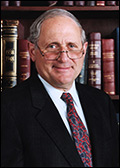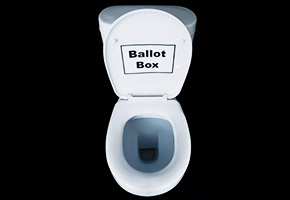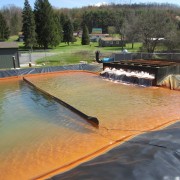Water answers from the blue party: Obama responds to science policy questions
by C.T. Pope
Circle of Blue
UPDATE: Since the original posting of this article, John McCain also responded to the science policy questionnaire.
As the presidential race ratchets into high gear this fall, science and energy policies are edging into the debates of both parties. Barack Obama became the first presidential hopeful to answer a 14-question survey produced by Science Debate 2008 in collaboration with Scientists & Engineers for America (SEA).
With the U.S. facing an era of water scarcity, Obama stressed conservation and innovation. He outlined, among other things, his energy, technology, space and water agendas.
“Prices and policies must be set in ways that give everyone a clear incentive to use water efficiently and avoid waste,” he responded to the query. “It is also critical that we undertake a concerted program of research, development, and testing of new technologies that can reduce water use.”
Calling water one of the “grand challenges” facing the U.S. in the 21st century, Obama recognized the power and necessity of a strong science policy but also criticized the current climate of reduced federal funding for scientific research.
“Our science agencies are often able to support no more than one in ten proposals that they receive, arresting the careers of our young scientists and blocking our ability to pursue many remarkable recent advances…in this environment, scientists are less likely to pursue the risky research that may lead to the most important breakthroughs,” he said.
In addition to the presidential questions, the initiative also includes seven questions for congressional incumbents and hopefuls. The project’s supporters and participants include the National Academies, Circle of Blue and the World Wildlife Fund.
SEA’s questionnaire has generated responses from over 80 House and Senate hopefuls — including incumbents Senator Carl Levin (D) of Michigan and Representative Ralph Hall (R) of Texas. Hall is the ranking Republican of the Science Committee.
Circle of Blue recently discussed the project with SEA’s executive director Lesley Stone.
What compelled SEA to ask these questions?
The politicians we select this election cycle will have a real effect on how we respond to the demand for energy, climate change, healthcare, maintaining our competitive edge, and a number of other issues that hinge on science. SEA wanted to make sure that voters knew what the people that want to represent them think about these issues, and to raise the visibility of science in the elections. It’s a voter education initiative, because these issues are central to our future.
How has the response been?
The response has been slow but steady, and we’re still collecting the candidate’s answers. Both parties have been responding. Science isn’t a Republican or Democratic issue, it’s an issue that everyone that cares about the country’s future needs to focus on.
Obama has already answered the questions; what are expectations for the McCain camp?
We hope Senator McCain will answer soon, and when it happens, we’ll make sure that the public has easy access to his views on science and technology. For now, his page on our SHARP Network describes some of his views on science and tech.
Who are the central players driving this initiative?
This is the first time that the scientific societies came together to write science and technology questions for candidates with one voice. One of SEA’s goals is to make sure that politicians are talking about their views on science policy in time for the elections. We wanted to have a candidate questionnaire, and to make it something that candidates would answer. We asked the nation’s largest scientific societies to partner with us.
We gathered representatives from several groups around the table, and considered a lot of possible questions — from ones submitted by SEA members, to some asked in previous elections, and even early questionnaires in this election. It was a collaborative process, and we came up with seven questions because we thought those topics were extremely important. We didn’t want the candidates to be overwhelmed by too many questions.
For the Presidential questions, Science Debate 2008 had been working on questions to ask at a live debate. They were part of our coalition, and wanted to have more questions for Presidential candidates to fill the traditional 90 minute stretch of a debate. We didn’t want the Presidential candidates to end up getting two sets of questionnaires, so we combined the two.
C. T. Pope is a Circle of Blue staff writer and researcher. Reach him at circleofblue.org/contact. Inset top image from Obama for America, portraits of the representatives courtesy of United States Federal Government (public domain).
Circle of Blue’s east coast correspondent based in New York. He specializes on water conflict and the water-food-energy nexus. He previously worked as a political risk analyst covering equatorial Africa’s energy sector, and sustainable development in sub-Saharan Africa. Contact: Cody.Pope@circleofblue.org












In the last several years the U S population increase has been largely due to immigration. Current population is about 310 million. By the year 2050, many experts estimate the population will increase anywhere from 420 million to 450 million.Almost 2/3 or 66% of this increase will be through immigration.
Question: How can the U S obtain a sufficient source of water to support an increase of 110 t0 140 million people?